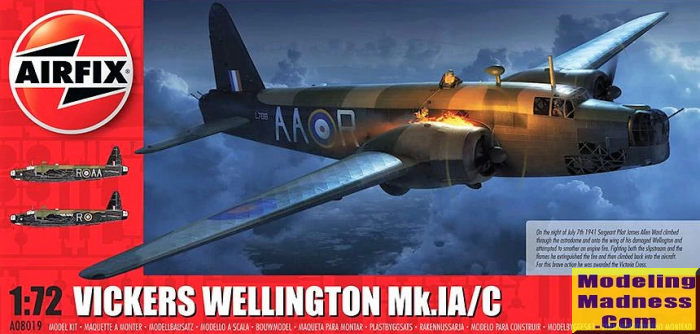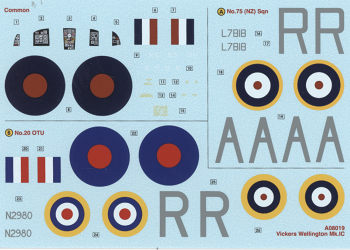
Airfix 1/72 Wellington IA/C
| KIT #: | A08019 |
| PRICE: | Delivered prices range from $41 - $68.00 |
| DECALS: | Two options |
| REVIEWER: | Scott Van Aken |
| NOTES: |
. |

| HISTORY |
The Vickers Wellington is a British twin-engined, long-range medium bomber. It was designed during the mid-1930s at Brooklands in Weybridge, Surrey, led by Vickers-Armstrongs' chief designer Rex Pierson; a key feature of the aircraft is its geodetic airframe fuselage structure, which was principally designed by Barnes Wallis. Development had been started in response to Air Ministry Specification B.9/32, which was issued in the middle of 1932. This specification called for a twin-engined day bomber capable of delivering higher performance than any previous design. Other aircraft developed to the same specification include the Armstrong Whitworth Whitley and the Handley Page Hampden. During the development process, performance requirements such as for the tare weight changed substantially, and the engine used was not the one originally intended.
The Wellington was used as a night bomber in the early years of the Second World War, performing as one of the principal bombers used by Bomber Command. During 1943, it started to be superseded as a bomber by the larger four-engined "heavies" such as the Avro Lancaster. The Wellington continued to serve throughout the war in other duties, particularly as an anti-submarine aircraft. It holds the distinction of having been the only British bomber that was produced for the duration of the war, and of having been produced in a greater quantity than any other British-built bomber. The Wellington remained as first-line equipment when the war ended, although it had been increasingly relegated to secondary roles. The Wellington was one of two bombers named after Arthur Wellesley, 1st Duke of Wellington, the other being the Vickers Wellesley.
| THE KIT |
The first thing I noticed while going through the instructions is that Airfix has pointed out those interior parts that will be difficult or impossible to see once the model has been built. This will allow the build time to be shortened for those who would normally eliminate some of those items anyway.
You are provided an extensive
interior that extends from the cockpit back to the en
One can do a raised or lowered
landing gear and before building up the nacelles a choice needs to be made.
Again, this pertains to doors. You do have to install the gear attachment
Props and spinners are part of
the gearbox of the engine and can be attached after the model is painted. Fore
and aft turrets are nicely detailed and seem to be items that can be assembled
with minimal fuss. They are not designed to rotate so can be added after
painting. A nice touch are two cockpit canopies, one with the pilot's window
slid back.

Instructions are excellent with the usual Humbrol only paint numbers. A separate painting and markings guide is provided for two planes, both painted in dark green/dark earth over black. The upper colors seem a lot more washed out than any paints I have of these shades. One is from 20 OCU and the other is the box art plane that shows the crewman climbing out on the wing of the aircraft to put out an engine fire. He survived and was awarded the Victoria Cross. The decal sheet itself is superbly printed.
| CONCLUSIONS |
There are those who would tell you to toss your other 1/72 Wellingtons, but really, most kits, regardless of age, deserve to be built. This is just the best one to date of this aircraft and I think will very much please fans of the type.
| REFERENCES |
If you would like your product reviewed fairly and fairly quickly, please contact the editor or see other details in the Note to Contributors.
Back to the Main Page Back to the Review Index Page Back to the Previews Index Page